October 18
lecture series
LAETIFICAT COR HOMINIS. WINE CULTURE IN NAVARRA
Grapes and vines in Navarrese art
Ricardo Fernández Gracia
Chair of Navarrese Heritage and Art
Vine and daily life
The wealth generated historically by the vine in Navarre has been very important. Testimonies from Roman times and, above all, from the Middle Ages show that the vineyards in Navarre surpassed the current area , given their use for liturgical purposes and for self-consumption. Most of the urban centers were surrounded by a real belt of vineyards that, in addition to supplying consumption, constituted a source of wealth for merchants and artisans. Throughout the XVI and XVII centuries there was a great increase in vineyards at the expense of the wheat area, and to avoid surpluses, it was forbidden to plant more vines in fields destined for cereals. In the 19th century, Navarre had its viticultural splendor as a consequence of the phylloxera crisis in France. However, that status was short-lived because the same plague spread to Navarre's vineyards and only 1,000 hectares were saved. Some municipalities have the grapevine in their local heraldry and the emblems of the Sociedad de Amigos del País de Tudela, in their two engraved versions of 1778 and 1779, present beautiful bunches of grapes and the first of them a grapevine.
Testimonies of that reality are provided by some cultural goods from different periods. Everything related to wine, as well as handicrafts and visual arts, had an outstanding development , since artistic manifestations are nothing but a reflection of the historical context in which they are developed, as well as a means of communication between men.
Roman art pieces
Archaeological evidence such as the Roman villa of Liédena or that of the Muses of Arellano, with complete winemaking facilities, amphorae such as those of Arellano, Cascante and Cintruénigo, or the cellars of Falces and Funes speak of the trade and the importance of wine in these lands. The amphorae, on the other hand, speak of the vigor of production, while in other places where wine was not exported, such as the aforementioned Villa de las Musas, dolias or jars have been found.
The Museum of Navarre has some outstanding pieces of Roman art decorated with bunches of grapes. A fragment of a mausoleum from Eslava presents a relief of grapes and vines, in one of the sides of a votive altar from Aibar we find a jug and a bunch of grapes and the funerary stele from the Shrine of Our Lady of Fair Love of Gastiain shows in its frame a succession of branches and bunches of grapes that, as it is known, were typical of the Dionysian cult, very abundant in the whole Roman world and with a deep eschatology, as we know, were typical of the Dionysian cult, very abundant throughout the Roman world and with deep eschatology, considering that wine opened the way to knowledge and eternal happiness. The mosaic of Ramalete, belonging to the Lower Empire, also presents beautiful bunches of grapes.
Medieval art
Grapes appear in numerous Romanesque works, as in the doorway of the monastery of Leire or in the pilasters and abacuses of the capitals of the cloister of the cathedral of Tudela. Leaves of vines and grapes multiply in the Gothic period, as shown in the capitals and keystones of the cathedral of Tudela, although where these motifs stand out for their significance is in the doorway of Santa María la Real de Olite, a masterpiece of radiant Gothic, dating from the last years of the 13th century. Its recent restoration is an example of how color was fundamental in this subject of works, particularly in those of the Gothic period.
A series of reliefs of monumental sculpture from the leave Age average sample bunches of grapes and grape harvesters at work. At the head of all of them, the capital of the grape harvesters of the cloister of the cathedral of Pamplona, from the first half of the 14th century, located in a context of country scenes, minstrels, acrobats, jongleurs, festivals and tournaments. The capital belongs to the north wall and sample shows a succession of three moments of agricultural work: a man bending down leaving grapes in the basket, another carrying the basket and a third pouring its contents into another container. In two keystones of the same cloister there are representations of the pruning of the vineyard and the transfer of the wine, corresponding to the months of March and September.
A little later is the relief with the same topic of the grape harvest of the frieze of the façade of San Pedro de Olite that adds the figure of the donkey and from the third quarter of the 14th century date the figured capitals of the southern doorway of Ujué, where we find another complete and exquisite representation of grape harvesting, with women cutting clusters that they introduce in wickerwork and a third character, who empties the same on the bunches that another individual places on a horse.
In the Gothic cloister of the monastery of La Oliva there are also scenes of the grape harvest, with several figures half hidden behind large branches and bunches of grapes. Likewise, in other 14th century examples such as the capitals of the church of the Holy Sepulchre in Estella and the doorway of the parish church of Riezu, there are reliefs with themes of grape harvesting.
The image of Our Lady of Arnotegui, typologically Romanesque but from the 13th century, holds a bunch of grapes in her right hand, but since it corresponds to a restored part, it is not possible to be sure if it was in the original carving or if it is a historical fake. In the church of La Magdalena in Tudela, a late Gothic sculptural group of Saint Anne with the Virgin and Child from Antwerp is venerated, which is known as Saint Anne the Old and must date from around 1530, when the city made a vow to Saint Anne, after the city was freed from the plague. A large bunch of grapes is offered by the grandmother to the Child who approaches to take one of the grapes.
In Arróniz, the image of Nuestra Señora de las Viñas, the titular image of Shrine of Our Lady of Fair Love, built in 1712 on the site of a medieval building, has disappeared.
The Renaissance and Baroque centuries
The 16th century does not have, contrary to what one might think, a prominent presence of grapes and vines. The image of the Virgin of Grace of San Pedro de Olite belongs to that century and sample to Mary offering the Child a big bunch of grapes. Another Marian image, the Virgin of the Miracle of Luquin, dated in the decade of the seventies of the XVI century and polychromed in plenary session of the Executive Council XVIII century, also offers a bunch of grapes to the seated Child.
In some alms dishes of the 16th century, imported from Europe, bunches of grapes also appear both in decoration and in stories. It was in the following century when the presence of grapevines spread to unprecedented proportions. Thus, we find them in the Solomonic columns, during the second half of the 17th century, at first, in the tabernacles and temples destined to the reservation and exhibition of the Blessed Sacrament, for obvious reasons of Eucharistic meaning. But very soon they would go on to dress the orders of columns of the altarpieces. Particularly beautiful are examples in which grapes, vine branches and vine leaves appear beautifully polychromed in their colors around 1660-1690, because at the end of the century the columns and all the decorative motifs began to be gilded, eliminating all color and losing much of the perception of the different elements. We will highlight a couple of outstanding examples. In the first place, the altarpiece of the Yugo de Arguedas, work of Pedro Biniés and José Serrano (1679) with polychromy by Francisco de Plano (1684), for which he expressly requested that "columns with golden fields and grapes and vine shoots imitated to the natural".. In the altarpiece we find clean gold in most of its elements, along with color and hook work. Thus, the blues and reds stand out in the cartouches, combined on their faces and backs, plus a symphony of different tones in the heathers, pomegranates, artichokes, grapes, vine leaves and vine shoots that are distributed in the Structures of the altarpiece. Something similar, although without so much detail, can be seen in the main altarpiece of the Poor Clares of Estella, the work of Juan Barón Guerendiain and the gilder Juan Andrés de Armendáriz (1678). Angels holding and surrounded by pinjantes of fruits and enormous bunches of grapes appear in the main altarpiece of Los Arcos (1655-1677).
Numerous pieces of liturgical furnishings, such as ostensories, ciboria and chalices incorporated vines in their ornamental repertoire, due to their Eucharistic function. Perhaps the most spectacular is the knot in the form of a bunch of grapes, from Nuremberg, from the monstrance of the Recoletas of Pamplona, a work from the second third of the 17th century. Something similar occurs in the embroideries destined for the same purpose, particularly in the palliums. In that of the Poor Clares of Estella, work of José Gualba (1762), there are beautiful bunches of grapes next to the ears of wheat framed by rocailles.
A saint with a special relationship with wine is Saint Ubaldesca (1136-1205), a member of the Order of Saint John of Jerusalem (based in Malta since 1530). She is depicted in two canvases from the end of the 17th century in Corella and Tafalla. She is dressed as a nun in the habit of her order with the cross of Malta on her chest, accompanied by a vine and carrying a vessel, preparing to bless its contents, in memory of a miracle by which she turned water into wine. In Tafalla it must have been very popular, because we also find it in the altarpiece of San Isidro (1734), together with San Lambert, patron saint of the Aragonese farmers. In the end, all three were protectors of crops and farmers. In Corella, the altarpiece of Santa Ubaldesca was paid for by her confraternity founded in the city in 1687, in the convent of La Merced. Its altarpiece, built in 1689, was made by Pedro Pascual and Martín de Irisarri. The canvas of the patron saint, with its well-known iconography, based on a print, is the work of Pedro Crespo, trained in the house-workshop of Vicente Berdusán. In those same years, in 1686, the life of the saint was published in Perpignan by Father Juan Ruiz Lumbier, proclaiming the saint on the cover of the publication as "defender of the fields and sovereign warrior against locusts, stone and lightning".
Without departing from painting, we must remember, on the one hand, the beautiful trays with grapes and fruits that we find in some paintings, as in the Holy Family with San Juanito of the Recoletas of Pamplona of the XVII century and another Holy Family of Miguel Jacinto Meléndez of the Comendadoras of Puente la Reina (1722). On the other hand, the decorative painting of the dome of the Shrine of Our Lady of Fair Love de la Virgen del Soto de Caparroso, work of Andrés Mata and Pietro Bardini (1775-1776), which represents, among other passages, that of the grapes of the promised land, with the great cluster carried by two of those sent by Moses and which recalls the biblical text(Numbers, 13:24). The two bearers, Joshua and Caleb, according to St. Augustine, are the Old and the New Testament; the former, who turns his back on the grapes and does not see what he is carrying -aversafacie-, symbolizes the Jewish people who close their eyes to the truth, while the one who goes behind and has his gaze fixed on the mystical cluster is the image of those who are united to Christ.
The centuries of the Baroque were of a symbolic culture and the vines and grapes did not escape those games of wit and wit, typical of the time. Of particular interest is an allegory of the abundance of the parish of Los Arcos, which together with three other compositions of the same subject are located in the Wayside Cross of the parish. All of them tell us about the person who had been the soul of the baroque style of the temple with the illusionist paintings carried out by José Bravo: Don Francisco de Magallón y Beaumont, V Marquis of San Adrián, mayor of Los Arcos in 1742, a convinced enlightened man with a wide culture. Interested in the wine business because of the strong economic repercussions for the town's Economics , he defended with solid arguments before the Cortes de Navarra that there was no need to remove the communal area of Los Arcos to solve the problems arising from the export of wine, as if it were an impediment to the reintegration of the town into Navarra.
Another example of symbolic and emblematic use is found in the eighteenth-century edition (1766) of the Annals of Father Moret and other works by the same author, which was illustrated. In the headers of the apologetic Congresses there are emblems destined to gloss the arduous task of the historian to make the truth flourish, which are to be inserted in the polemic between Father Moret and Father Larripa and other Aragonese chroniclers of the time. For the eighth congress, Father Solano, the Jesuit in charge of the 1766 edition, chose an emblem of Francisco Nuñez de Cepeda published in his Idea of the Good Shepherd ... (1682), in which appears a bower with a pruning shear and vine shoots on the ground, next to his motto in which one reads: "Proficit iniuria" (Injuria le aprovecha). To model was added in the Navarre example, drawn by José Lamarca, the figure of the pruner to make the message clearer and more evident. The commentary of the emblem refers to the strengthening in adversity and resistance to slander, comparing the benefits of pruning with the pain of insults and murmurings that, in the end, are like "the iron that cauterizes".
Vines could not be missing in the portrait of the reformer King Carlos III, VI of Navarre. Laurels, palms, grapes and vines are shown in the border of the portrait of the monarch kept in the Town Hall of Tudela and work of Diego Díaz del Valle in 1797.
Nineteenth and twentieth centuries
In the nineteenth century, with its new realities around the teaching of the arts and particularly the School of Drawing of Pamplona and the importance of the programs of study from life, there was an interest of painters in still lifes, picking up the best of the tradition of our Golden Age. The inventories of canvases of the houses of a certain position in the 19th century show the presence of still lifes, in which bunches of grapes had their protagonism.
One of the canvases of the Basilica of San Gregorio Ostiense that narrates its legend and relationship with Navarra, specifically the one that presents the farmers of La Rioja and Navarra desolate and afflicted by the plague of locusts, sample us men of the countryside before their civil and religious authorities showing them the ravages of the plague in wheat fields and vineyards very battered by the disease. It is the work of the painter Ramón Garrido from Aachen, painted in 1831.
Lithographed labels of 19th and 20th century wineries are another example of the exquisiteness of the bottling process. The furnishings of private homes incorporated grapes in tablecloths and napkins, as well as in the viticultural cloths, in the latter case together with other Eucharistic motifs.
In the 20th century, painters such as Javier Ciga and Muñoz Sola have left very clear and with high levels of technique and mastery of color, each with their own particular formal grammar, notable and outstanding examples of still lifes, some of them with grapes of different varieties. Photography did not remain oblivious to the capture of grapes and especially grape harvest scenes, as can be seen in some examples of Fernando Galle, preserved in the Museum of Navarra.
An interesting chapter is the presence of vines on the facades and buildings of wineries, as well as on the labels, stamped paper and advertising of bottled wines from the 19th century to the present day in Navarre.

1.- core topic of the gothic cloister of the cathedral of Pamplona corresponding to the month of September with the racking of wine
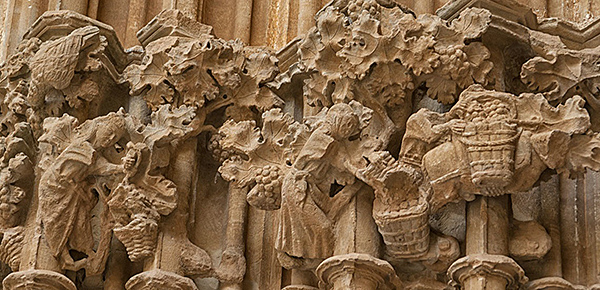
2.- Grape harvest scene on the Gothic façade of Ujué, third quarter of the 14th century.
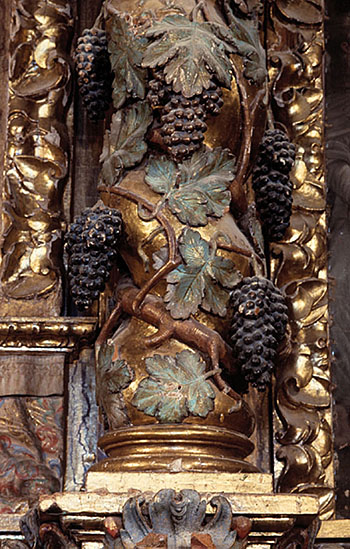
3.- Solomonic column of the altarpiece of the Yugo sanctuary, 1679-1684.
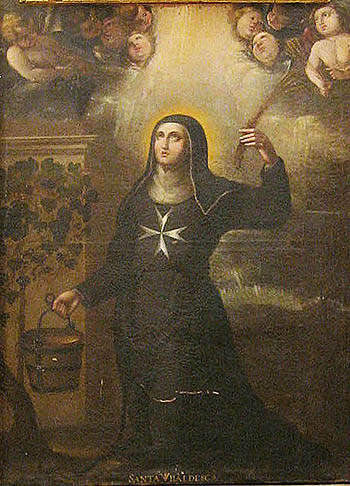
4.- Canvas of Saint Ubaldesca in Corella, by Pedro Crespo, 1689.
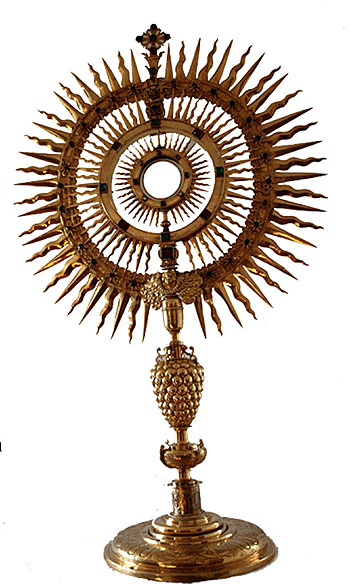
5.- Ostensory of the Augustinian Recollect Nuns of Pamplona, second third of the XVII century.
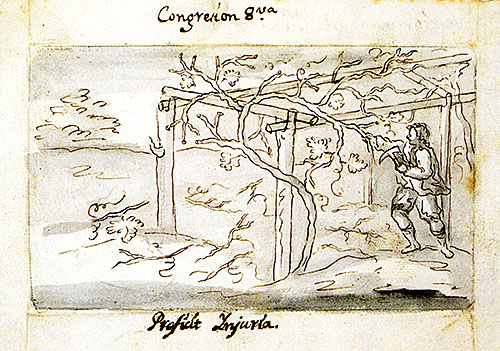
6.- Preparatory drawing for the engraving of the Eighth Congress of Father Moret, by José Lamarca 1766.
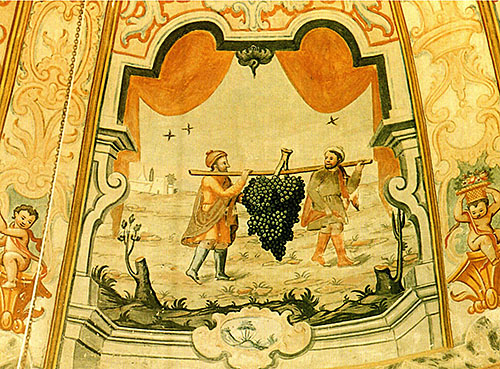
Detail of the dome of the Shrine of Our Lady of Fair Love de la Virgen del Soto de Caparroso, 1775-1776.
